Art & Exhibitions
A Parade of 100 Elephant Sculptures Makes a Jumbo Entrance in New York
The life-sized sculptures were made by indigenous artisans—and you can buy one to support wildlife conservation.
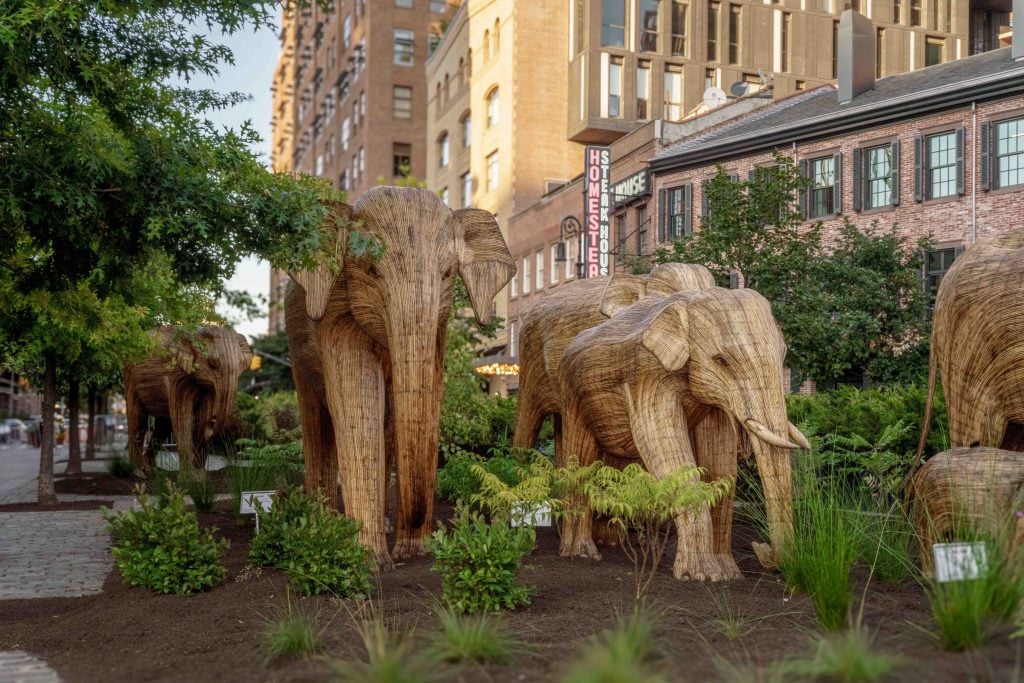
A herd of elephants has descended on New York, making their way down the cobblestone streets of the Meatpacking District in what’s being hailed as the largest outdoor public art installation in the city since Christo and Jeanne-Claude’s The Gates in 2005.
Titled “The Great Elephant Migration,” the project features 100 life-size sculptures of Indian elephants crafted over the last five years by the Coexistence Collective, a team of 200 Indigenous artisans from Nilgiri Biosphere Reserve in South India.
The traveling exhibition is raising money for 22 partnering conservation non-governmental organizations, or NGOs dedicated to saving not only elephants, but various types of wildlife. Each stop on the tour will also benefit a local nonprofit. In New York, that’s the Wild Bird Fund.
It has the backing of celebrities supporters including Cher, Padma Lakshmi, Susan Sarandon, Waris Ahluwalia, and Diane von Furstenberg, as well as Ann Philbin, director of the Hammer Museum at the University of California, Los Angeles, and artist Joana Vasconcelos. (In a nod to elephants’ familial structure, the largely female group is called the Matriarchy.)

“The Great Elephant Migration” in New York’s Meatpacking District. Photo by Jim Fryer and Iri Greco courtesy of BrakeThrough Media and the Great Elephant Migration.
The public art project is the brainchild of Ruth Ganesh, a British animal rights activist. She cofounded the collective, which is part of the Real Elephant Collective nonprofit, with Tarsh Thekaekara, an elephant researcher and scientist who lives in India.
It was his idea to make the sculptural herd from an invasive weed known as lantana camara, which is threatening native species and their habitats across India by overtaking forests and driving animals out of their homes. The plant has spread across an estimated 115,000 square miles of India’s protected forests and preserves.
That means the project is actually directly fighting the threat of an invasive species while raising money and awareness for environmental issues. The collective isn’t just using lantana as a sculpting material; it is also converting tons of it into biochar, a black carbon produced from agricultural waste products that is rich in nutrients. The biochar is then buried to improve the soil in India.
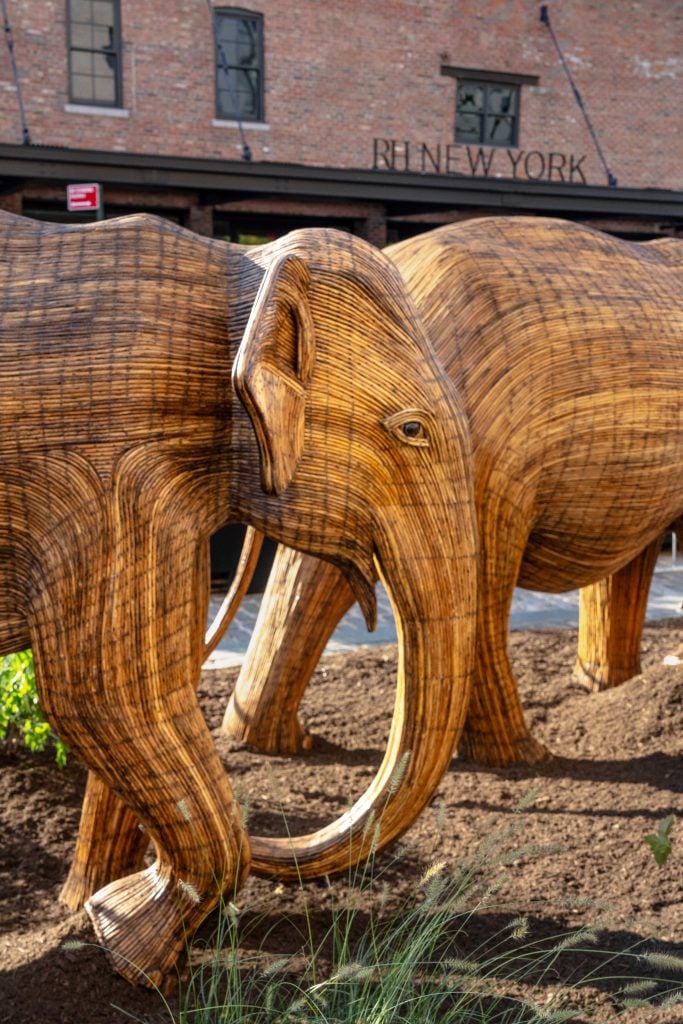
“The Great Elephant Migration” in New York’s Meatpacking District. Photo by Mark Warner courtesy of the Great Elephant Migration.
The elephants are for sale, with the artisans continually crafting new members of the herd—each one takes three months—to match collector demand (and therefore helping remove more lantana). A five-foot-tall baby elephant costs $8,000, with 15-foot-tall adult males with tusks available for $22,000.
Organizers have already sold more than 100 and raised over $1 million. The goal is to sell 1,000 of the elephants, to raise $10 million in total. (The exhibition cost $2 million to stage, with corporate sponsors including Indian fashion house Sabyasachi.)
Each sculpture is designed by Thekaekara’s wife, Shubhra Nayar, and is based on and named after an actual, individual elephant living today, mostly from the biosphere reserve’s Nilgiri Hills. (Two are elephant rescues from the Sheldrick Wildlife Trust in Nairobi, Kenya, one of the NGOs recipients.)
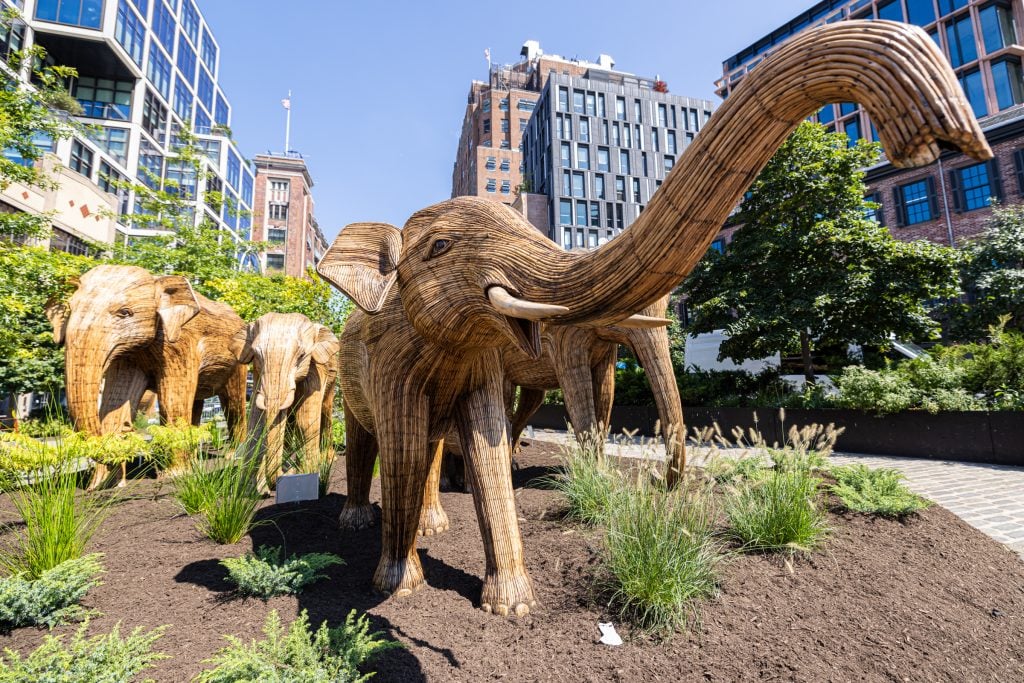
“The Great Elephant Migration” in New York’s Meatpacking District. Photo by Jim Fryer and Iri Greco courtesy of BrakeThrough Media and the Great Elephant Migration.
“The vision of 100 hand-made Indian elephants migrating across America in my mind, is a monumental, cinematic and moving work of performance art,” curator Dodie Kazanjian, founder of Rhode Island nonprofit Art and Newport, which is co-presenting the exhibition with the Meatpacking District Management Association, said in a statement. “I see these elephant sculptures descending from the superb 16th-to-18th-century royal elephant portrait paintings, where every elephant had its own name.”
The artisans, who are part of the Soligas, Bettakurumbas, Kattunayakan, and Paniyas tribes, live alongside the elephants and know their individual quirks and personalities.
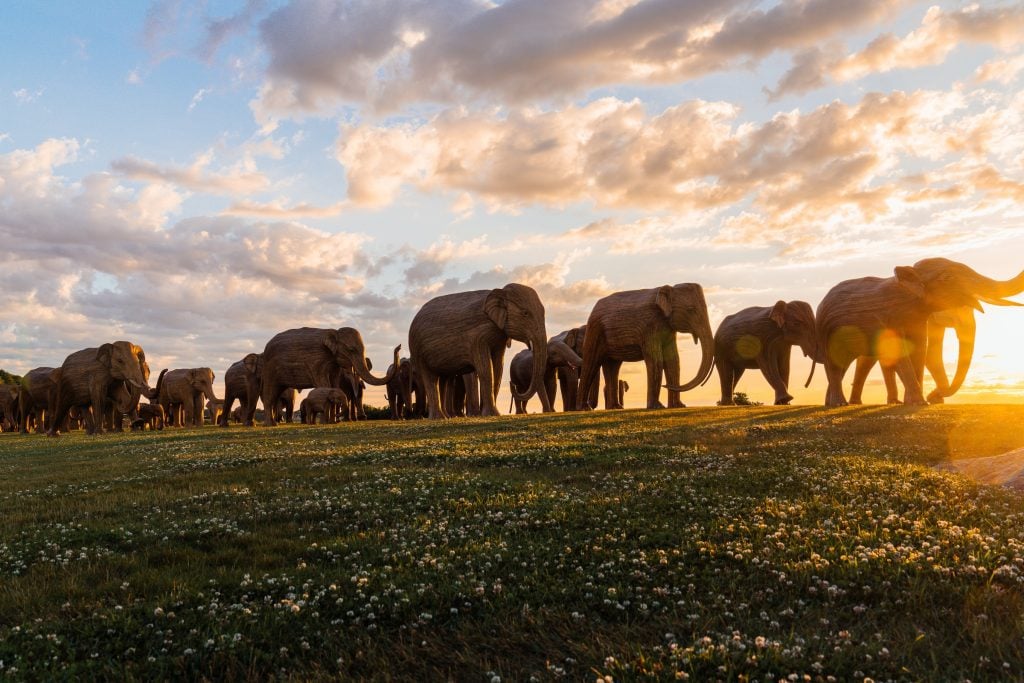
“The Great Elephant Migration” at Rough Point mansion in Newport, Rhode Island. Photo courtesy of the Great Elephant Migration.
It’s that kind of peaceful coexistence that the project is meant to support.
“We don’t want to think of conservation in the traditional way of ‘Let’s preserve these little pockets of nature while we destroy the rest of the earth,’” Thekaekara told the New York Times, noting that elephants, despite their large size, are able to live peacefully on tea and coffee farms. “We can’t only think about nature as separated from ourselves.”
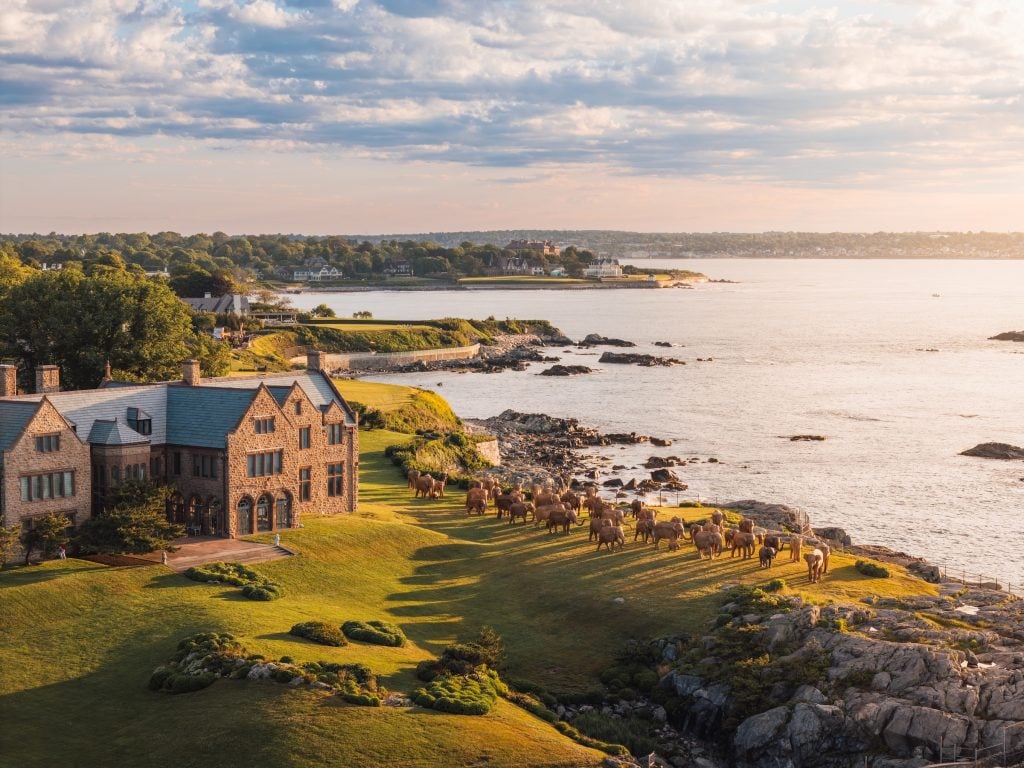
“The Great Elephant Migration” at Rough Point mansion in Newport, Rhode Island. Photo courtesy of the Great Elephant Migration.
The elephants have already made a splash in New York, where they are on view along 9th Avenue, between Gansevoort Plaza and West 15th Street.
“I’ve seen people with a suit on—they might be going to work—put their bag down and come up to them, hug them, or put their hands on their flanks and look up into their eyes,” Ganesh told Vogue. “What I find most beautiful is just how the urge to touch them is so overwhelming.”
The sculptures are formed from a steel body structure, covered with lantana strips and accented with wooden toenails and tusks, and resin eyes.
In an effort to limit the project’s carbon footprint, the elephants will travel by a fleet of 100 electric trucks—one for each sculpture—decorated with traditional lorry art by George and Thomas, Indian truck artists from Tamil Nadu. (IBI International Logistics is providing free transportation and art handling for the project.)
The project first appeared in Kochi, India, during the Kochi Biennale in 2019, and in London in 2021. The tour kicked off in earnest this year at the Lalbagh Botanical Garden in Bangalore, India.
The elephants touched down stateside in July in Newport, Rhode Island, where they made for a dramatic vista overlooking the sea outside Rough Point, the former mansion home of heiress Doris Duke. There were also installations at Cornelius Vanderbilt II’s Gilded Age Mansion the Breakers and on the lawn of Salve Regina University.
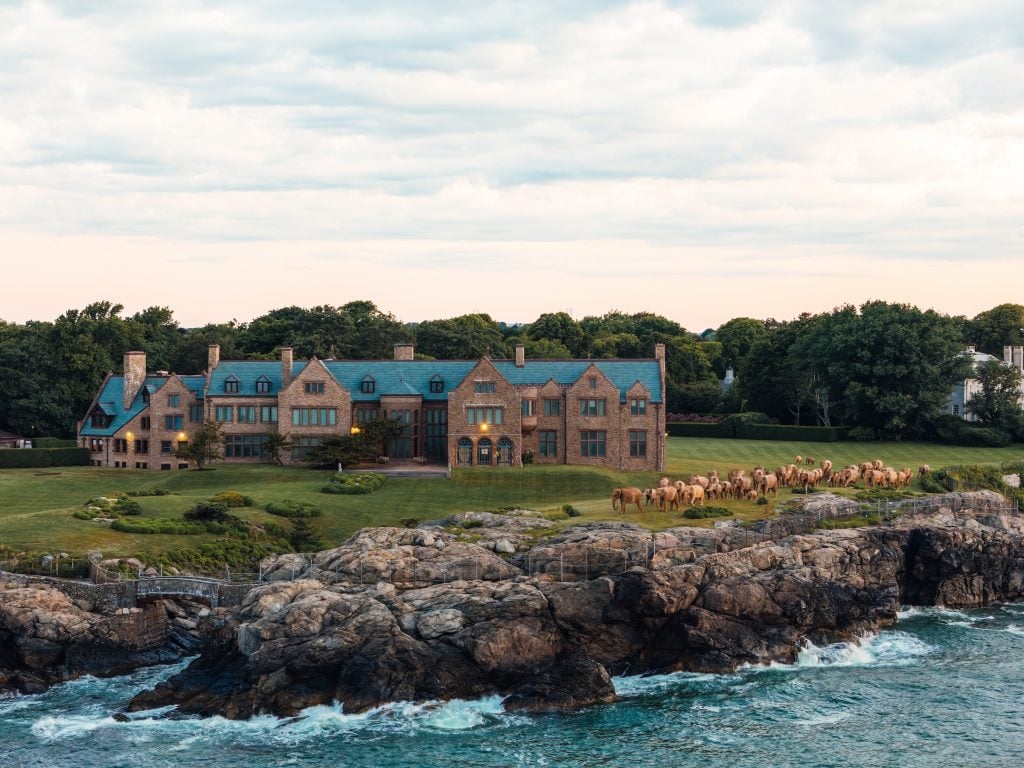
“The Great Elephant Migration” at Rough Point mansion in Newport, Rhode Island. Photo courtesy of the Great Elephant Migration.
The next stop will be in Miami Beach in December, just in time for Art Basel Miami Beach. The itinerary continues next year with the Blackfeet Nation in Browning, Montana in May; Jackson Hole, Wyoming, in June; and Los Angeles in July. The tour, which hopes to add stops in Houston and Montana’s Glacier National Park, is organized by the conservation group Elephant Family USA.
In New York, “Migration” will be accompanied by two additional elephant exhibitions, by artist Hadi Falapishi at 82 Gansevoort Street later this month, and photographer Michael Turek at 423 West 14th Street, October 18 to 20.
“The Great Elephant Migration” is on view in the Meatpacking District, New York, September 6–October 20, 2024.





